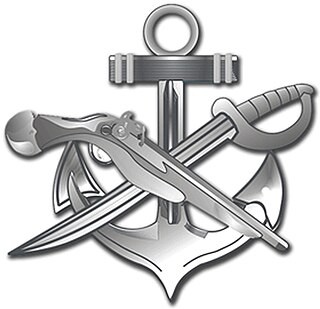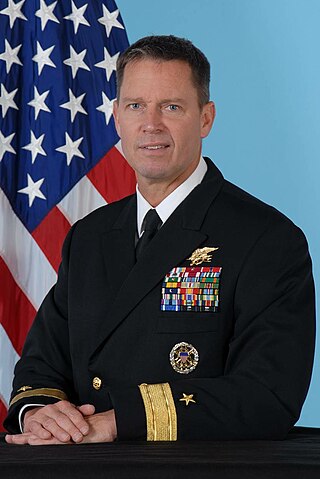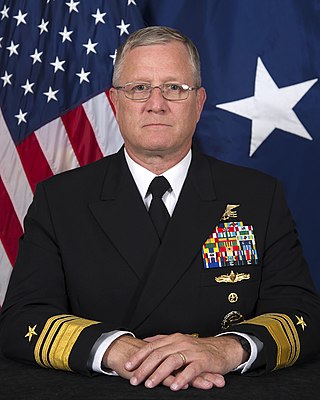
The United States Navy Sea, Air, and Land (SEAL) Teams, commonly known as Navy SEALs, are the U.S. Navy's primary special operations force and a component of the Naval Special Warfare Command. Among the SEALs' main functions are conducting small-unit special operation missions in maritime, jungle, urban, arctic, mountainous, and desert environments. SEALs are typically ordered to capture or kill high-level targets, or to gather intelligence behind enemy lines. SEAL team personnel are hand-selected, highly trained, and possess a high degree of proficiency in unconventional warfare (UW), direct action (DA), and special reconnaissance (SR), among other tasks like sabotage, demolition, intelligence gathering, and hydro-graphic reconnaissance, training, and advising friendly militaries or other forces. All active SEALs are members of the U.S. Navy.

Stephen Scot Oswald is an American former pilot and NASA astronaut.

The SEAL Delivery Vehicle (SDV) is a crewed submersible and a type of swimmer delivery vehicle used to deliver United States Navy SEALs and their equipment for special operations missions. It is operated by SEAL Delivery Vehicle Teams.

The United States Naval Special Warfare Command (USNSWC), also known as NAVSPECWARCOM and WARCOM, is the naval component of United States Special Operations Command, the unified command that oversees and conducts the nation's special operations and missions.

Albert Melrose Calland III was a vice admiral in the United States Navy who was the deputy director for Strategic Operational Planning at the National Counterterrorism Center and commander of Naval Special Warfare Command from 2002 to 2004. He also previously served as Deputy Director of the Central Intelligence Agency from July 2005 to July 2006 and commanded the Naval Special Warfare Development Group from 1997 to 1999.

Christopher John "Chris" Cassidy is a retired NASA astronaut and United States Navy SEAL. Chris Cassidy achieved the rank of captain in the U.S. Navy. His first spaceflight was on a Space Shuttle mission in 2009. He was the Chief of the Astronaut Office at NASA from July 2015 until June 2017.

Naval Amphibious Base Coronado is a US naval installation located across the bay from San Diego, California. The base, situated on the Silver Strand, between San Diego Bay and the Pacific Ocean, is a major Navy shore command, supporting over 30 tenant commands, and is the West Coast focal point for special and expeditionary warfare training and operations. The on‑base population is 5,000 military personnel and 7,000 students and reservists. The base is one of the eight components of Naval Base Coronado (NBC).

Joseph Devereux Kernan is a retired United States Navy vice admiral and the former under secretary of defense for intelligence. His last military assignment was serving as the military deputy commander of the United States Southern Command (USSOUTHCOM), Miami, Florida, from May 23, 2011, to September 2013. He was the second-in-command of one of nine unified commands under the Department of Defense.

Eric Thor Olson is a retired United States Navy admiral who last served as the eighth Commander, U.S. Special Operations Command (USSOCOM) from July 2, 2007 to August 8, 2011. He previously served as Deputy Commander, U.S. Special Operations Command from 2003 to July 2007. Olson was the first Navy SEAL ever to be appointed to three-star and four-star flag rank, as well as the first naval officer to be USSOCOM's combatant commander. He took command from Army General Bryan D. Brown in 2007. Brown and Olson had served together at the SOCOM headquarters in Tampa for four years. He retired from active duty on August 22, 2011 after over 38 years of service. He relinquished command of SOCOM to Admiral William H. McRaven the same day.

Michael Patrick Murphy was a United States Navy SEAL officer who was awarded the U.S. military's highest decoration, the Medal of Honor, for his actions during the War in Afghanistan. He was the first member of the United States Navy to receive the award since the Vietnam War. His other posthumous awards include the Silver Star Medal and the Purple Heart.
Naval Special Warfare Group 3 (NSWG-3), based at the Naval Amphibious Base Coronado in California, was one of six constituent formations of the United States Naval Special Warfare Command. Until 2008, NSWG-3 was composed of two SEAL Delivery Vehicle Teams: SDVT-1 in Pearl Harbor and SDVT-2 in Little Creek. In 2008, SDVT-2 was disestablished and merged into SDVT-1, which was then now headquartered in Pearl Harbor and operated detachments in Pearl Harbor and Little Creek. SDV Teams are SEAL teams with an added underwater delivery capability. SDVT-2 was reactivated on 8 March 2019. NSWG-3 was deactivated alongside NSWG-10 in August 2021 and replaced by Naval Special Warfare Group 8 which took in all units previously under NSWG-3 and NSWG-10.

The Special Warfare Combat Crewmen (SWCC ) are United States Naval Special Warfare Command personnel who operate and maintain small craft for special operations missions, particularly those of U.S. Navy SEALs. Their rating is Special Warfare Boat Operator (SB).

Thomas L. Brown II was a retired United States Navy officer and the first Navy officer to command Special Operations Command South, based in Homestead Joint Air Reserve Base, Florida.

Brian Lee Losey is a retired rear admiral of the United States Navy. He headed the Naval Special Warfare Command from 2013 until his retirement in 2016. Losey is a native of Tacoma, Washington.
The Salvadoran Civil War was a military conflict that pitted the guerrilla forces of the left-wing Marxist-oriented Farabundo Marti National Liberation Front (FMLN) against the armed and security forces loyal to the military-led conservative government of El Salvador, between 1979 and 1992. Main combatants comprised:

Scott P. Moore, is a retired Rear Admiral of the United States Navy. Moore is a former member of SEAL Team TWO and previously served as commanding officer of the Naval Special Warfare Development Group from 2007 to 2009. He is an Admiral Circle member for the exhibit SEAL: The Unspoken Sacrifice. He is active in the Navy SEAL Foundation.

Timothy Gerard "Tim" Szymanski is a retired United States Navy vice admiral who last served as deputy commander of United States Special Operations Command from October 15, 2018 to December 2021. He is the former commander of United States Naval Special Warfare Command in Coronado, California.

Sean Averell Pybus is a retired United States Navy vice admiral who last served as the deputy Commander, United States Special Operations Command from 2014 to 2016. He previously served as the Commander, Naval Special Warfare Command from 2011 to 2013.

Thomas R. Richards is a retired United States Navy rear admiral who commanded the Naval Special Warfare Command from 1996 to 1999.

Keith Bently Davids is an American United States Navy special warfare officer with the rank of rear admiral. He has served as the commander of Naval Special Warfare Command since August 19, 2022. He was the commander of U.S. Special Operations Command South, United States Southern Command from 2020 to 2022. Previously, he served as director of the White House Military Office during the Presidency of Donald Trump. Earlier in his career, he was commanding officer of the Naval Special Warfare Center and SEAL Team One.


















